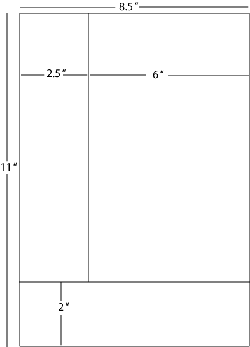Cornell System of Notetaking
Introduction
The Cornell System is a notetaking system that was developed at Cornell University several decades ago. It has been adopted by many colleges and universities in the United States and elsewhere.
What It Looks Like

As Figure 1 illustrates, the components (page areas) of the Cornell System are:
- a 2.5-inch margin on the left side used as a cue column;
- a 6-inch notes column on the right used for "regular" notetaking; and
- a 2-inch area at the bottom of each page used to summarize the main points of the page.
How To Use Each Component
Notes Column
The notes column is a 6-inch area on the right side of each page of your notes. Use it to take notes the way you regularly would.
- You could use an outline format.
- You could use headings and bullets.
- You can include graphic organizers.
The important thing is to keep your use of the notes column flexible, to best fit the type of material you are taking notes about.
Cue Column
The cue column is a 2.5-inch margin on the left side of each page of your notes. Leave the cue column empty until you're finished taking notes. Once you review what you've written down, use the cue column to create questions based on the material in your notes. That way, when you want to review, you can cover the notes column and quiz yourself using the questions you created.
Summary Area
In the summary area, try to sum up each page of your notes in just two or three short, concise phrases or sentences. Try to use this space to look at the big picture. Bulleted points work well or you can create a small graphic organizer if it seems appropriate.
The Cornell System by Steps
Now that you understand the layout of the Cornell System and the purpose of each area of the notetaking page, think of applying the system as a series of seven steps:
- Capture the book's or the speaker's ideas in the 6-inch notetaking column on the right side.
- Read over your notes to fill in gaps and make sure your writing is legible.
- Across from each important main idea in your notetaking column, write a question that you can use later to check your knowledge of the material.
- Cover the notes in the 6-inch column, so that all you can see are your questions in the cue column. Recite the answers to your questions, using your own words. Be sure to check each of your answers to make sure it is correct and complete.
- In the summary area of each sheet, summarize the most important points on that page.
- Review your notes immediately, making an effort to see the big picture, now that you've worked with the details.
- Spend a little time reflecting, asking questions such as:
- Why are these facts and ideas important or significant?
- How do they fit in with what I already know?
See the Cornell System example (PDF) provided. It will help you see what an actual application of the Cornell System might look like.